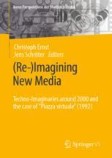Search
Search Results
-
The Emergence of the ‘Cy-Mind’ through Human-Computer Interaction
This chapter argues that the reason why AI can be so unsettling is not in how the powers of the technology alter what a computer (or computers) might...
-
An Introduction to Screenwriting for Virtual Reality
This introductory chapter presents an overview of recent developments in virtual reality as an entertainment medium and a review of related academic...
-
Misinformation, Paradox, and Nudge: Combating Misinformation Through Nudging
The rapid spread of misinformation online can be attributed to bias in human decision-making, facilitated by algorithmic processes. The area of...
-
Bodies/Technology on Standby: The Importance of Cooperative Waiting for Digital Work
Based on an ethnographic study of the production of visual effects, this chapter analyses the role of waiting in digital work. I argue that temporal...
-
Screen Spaces: Zones of Interaction and Recognition
This chapter considers how moving images generate new social spaces and encounters in front of the screen—horizontal zones of interaction and...
-
Interview with Stephen Wolfram
In this August 2022 interview, co-editors Juliet Floyd and James E. Katz converse with polymath Stephen Wolfram, whose expertise ranges from physics...
-
Past and Present Metaphors of Interaction and Virtuality
Since its very early days, metaphors have been used by more and less powerful social actors to try to convey what the internet is and what it can or...
-
The Child as a Social Construct
Coded kids in computer-generated environments remind us that much of what we assume to be biological, obvious, and consistent about childhood is, in...
-
What Is a Landscape?
The word ‘landscape’ refers to a world transformed by human activity, the desire to look back on it as if it were an image, and the feedback loop of...
-
Latent Memory, Responsibility and the Architecture of Interaction
“You know what I mean, out here in the real world you can genuinely prevent stuff, can’t you?” junior detective Blue Coulson (Faye Marsay) explains...
-
Reinventing the Wheel of Media Theory
The paper deals with the history of media theory before and after digital networked media. It identifies the premises of Classical Media Theory...
-
Towards Immersography: Considerations for an Integrated Understanding of Immersive Narrative Experiences
The concept of immersion has come to dominate the extended reality (XR) industries, leading to a renewed interest in the concept's relevance in...
-
Microbe Computing
“Microbe Computing” examines how assemblage processes divert. The central understanding of assemblages is informed by the Deleuze-influenced...
-
Playing with the Eyes. A Media History of Eye Tracking
This chapter focusses on eye-controlled digital gaming (recording and analysis of eye movement) as Augmentative and Alternative Communication (AAC)...
-
Tactical Ambiguity: Materiality, Representation and Interaction in Evan Meaney’s Glitched Portraits
This essay analyses how an ambiguous experience of art online enables a tactical user position. It does so with a rare combination of media theory on...
-
Perspective on Integral Communication
The three areas in which integral communication will play a particularly important role are personal development, organisational learning, and the...
-
Shifting Diegetic Boundaries
Cinematic Virtual Reality (CVR) lets viewers choose their gaze direction within cinematic content encircling them in 360 degrees and can in some...
-
Transforming the Role of Audio-Visual Content Producers in a Videolised Society
With videolised new media, audio-visual content producers have undergone fundamental changes. Their role has expanded from display and dissemination...
-
A Threefold Approach for Enabling Social Change: Communication as Context for Interaction, Uneven Development, and Recognition
In a context where research aimed to intervene on an increasingly unequal society is very necessary, we are bringing a theoretical framework intended...
-
Regulation of Violent Content in Virtual Reality
This chapter explores one of the paradoxical aspects of current virtual reality (VR) discourse, the emergence of industry commentators and academic...
